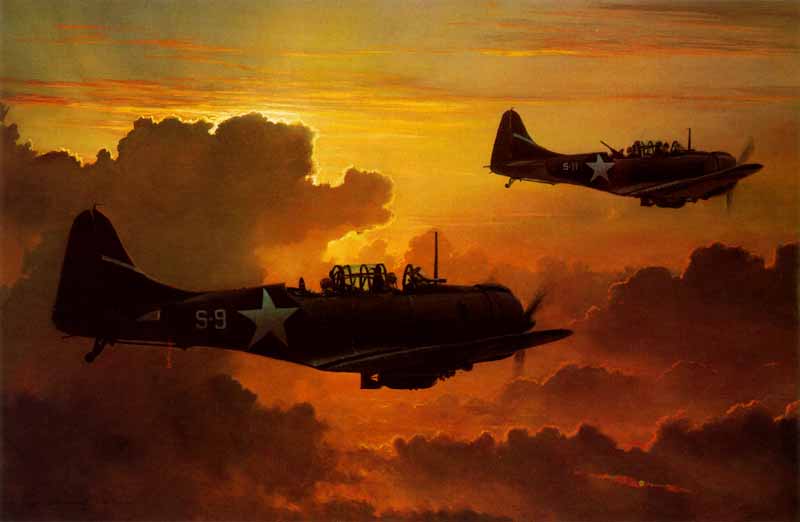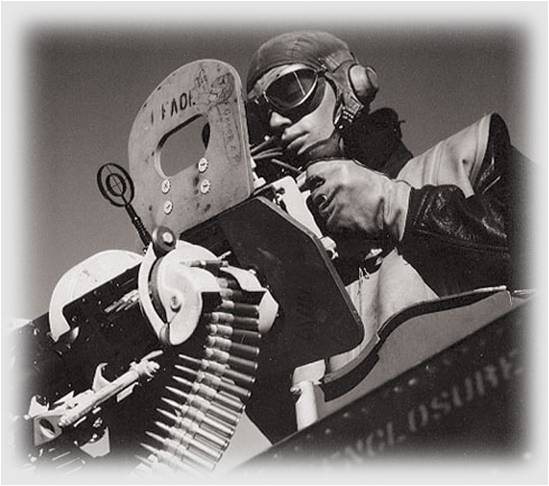Battle of Midway, Commanding Officer, USS Enterprise, Serial 0133 of 8 June 1942
At Sea June 8, 1942
From: The Commanding Officer.
To: The Commander-in-Chief, U.S. Pacific Fleet
Via: Commander Task Force Sixteen.
(Rear Admiral R.A. Spruance, U.S. Navy).Subject: Battle of Midway Island, June 4 – 6, 1942 — Report of.
1.) The attack delivered upon enemy carriers by the torpedo squadrons of our forces is believed to be without parallel for determined and courageous action in the face of overwhelming odds. These crews were observed to commence their attack against heavy anti-aircraft fire from the enemy carriers and supporting vessels while opposed by enemy Zero fighters in large numbers. The enemy fighter opposition was so strong and effective that ten torpedo planes out of fourteen of Torpedo Squadron SIX did not return. It is recommended that the Navy Cross be awarded to each pilot and gunner of Torpedo Squadron SIX who participated in this bold and heroic attack. A separate letter containing details of all aircraft attacks and specific recommendations for awards will be submitted. …
7.) It is extremely difficult to determine the extent of the damage inflicted upon the enemy by Enterprise, as the air groups of all carriers, as well as land based aircraft at Midway, participated in continuous attacks on enemy units throughout the three days action. Based upon reports available to Enterprise, it is estimated the following damage was inflicted upon the enemy:3 CV’s sunk.
1 CV on fire and badly damaged (probably sank night of June 5).
1 CA wrecked and abandoned.
3 CA heavily bombed.
3 DD sunk.
As a very young Lieutenant Junior Grade, I often kidded LCDR Pat Patterson that I didn’t know anyone so old they’d been in the Battle of Midway, so could he tell me what it was like. His reply – “What do I know, I was 19 years old and saw the whole thing backwards?” When he retired, I was the good humor man for his dinner. I got a copy of the Victory at Sea episode (3 parts) on Midway and ran it backwards.
In the Battle of Midway, Pat was a Petty Officer Third Class SBD gunner flying from the carrier Enterprise. (From Enterprise message: Aircraft 6B15, Ens. G.H. Goldsmith, A-V(N), USNR. PATTERSON, J.W., 387 23 15, ARM3c, USN) He said his pilot was a terrible dive bomber, but on that day as they pulled off the run, he saw their bomb hit dead center on the Japanese carrier flight deck. As fate would have it, they wound up landing on Yorktown rather than Enterprise just prior to the attack on Yorktown. As he unsaddled from the SBD Dauntless, a CDR ran out of the island, grabbed him and started accusing him of leading the Japanese strike force back to them. It took a bit but Pat finally got the CDR to recognize that he didn’t control much as the gunner in the back seat. Shortly thereafter he went over the side as Yorktown was ordered abandoned. No more had he hit the water, than a sailor landed right on top of him who couldn’t swim and almost drowned them both. Pat gave a quick dog paddling lesson and the rest is history.
Pat went on to getting into the enlisted aviator program. On the night WWII ended, Pat was taxing out for a night training mission in a Hellcat. Mission complete, the “boys” taxied in for some cold ones.
Pat went on to a full Navy career as a pilot. The earning of a Silver Star during the Korean War was combat efficiency par none. As a former enlisted aviator he was in a VC squadron doing air-borne target operations state-side when the war began. Similar to “Bridges at Toko Ri,” the Navy was losing aircraft going after a heavily defended bridge in North Korea. Pat got ordered to get CQ’d -carrier qualified – and was flown to Korea. He wound up running a special operation – one droned (radio controlled pilotless aircraft)Bearcat full of TNT, one control plane, Hellcat, and pilot (himself), carrier launched to dive bomb the “Cat” into the heavily defended bridge. Pretty effective – one launch, some flak, one bridge, one trap, come on home, one Silver Star.
Pat finished his career, retiring as a Lieutenant Commander supporting flight test operations at Point Mugu, California in the targets department.
Victor Davis Hansen has a fascinating book, Ripples of Battle, discussing the unintended consequences of battle- from ancient Greece to Okinawa. I inherited the unintended consequences (as a “stash” at the old Naval Missile Center Targets Department) of the Tet Offensive and the resulting “bombing halt” on targets in North Vietnam with resultant over pumping of new “wings” into the pipeline.
For me, as a newly gold winged Naval Aviator, that resulted in 600 hours in the F-8, F-9 and T-33 in 18 months before going A-7s in Lemoore. LCDR Patterson was Ops Officer for those flight test target missions at Point Mugu. His “air force” included QF-9, TF-9, QT-33, T33, T-28, P-2, and F-8 aircraft. I owe him much, as he understood well the issue of not going directly to a squadron and set up an excellent “training” program for his two stashed “nuggets.” I’m pretty sure that in that year and a half two of us sidelined “JGs” had more dissimilar ACM (air combat maneuvering – dogfighting), with more different types of performance qualities, facilitated by some of the highest quality “instructors” (NMC flight test and VX-4 including several MIG killers) than anyone anywhere. What a learning experience and what a hoot. I’m convinced it saved my ass a little later down stream over North Viet Nam, so am rightly thankful.
Like the Marine Corps, each service has its “old breed,” and those “old WWII prop dudes” could really fly; I once watched in awe as Pat flew down the runway at China Lake full throttle in a T-28, the propeller couldn’t have been more than a couple of feet off the runway.
For sometime now, 4 June has been cause to lift a young Scotch in remembrance of one really great Naval Aviator, boss and great friend: LCDR Pat Patterson – USS Enterprise SBD gunner at Midway, former enlisted aviator, Silver Star recipient, and my first boss after being designated a Naval Aviator.
In early June 1942, a battle was fought that turned the tide for the war in the Pacific in WW II, and forever established the “bonafides” of naval carrier based air – Midway.
Fought 71 years ago, here’s to LCDR Pat Patterson and to all who led the way.
Fly Navy the VERY BEST Always Have






